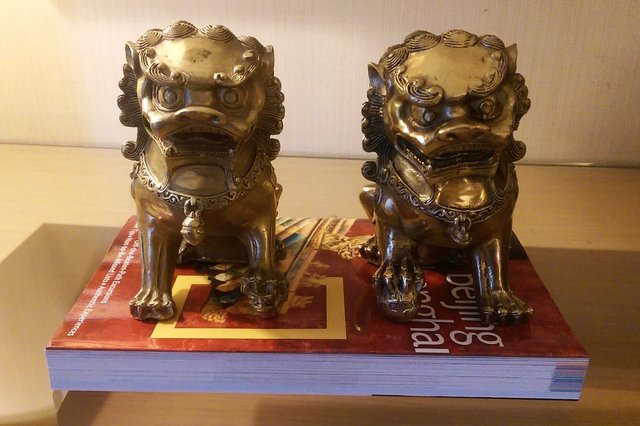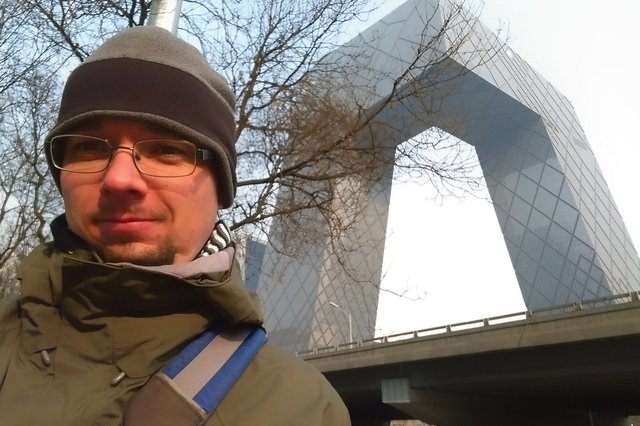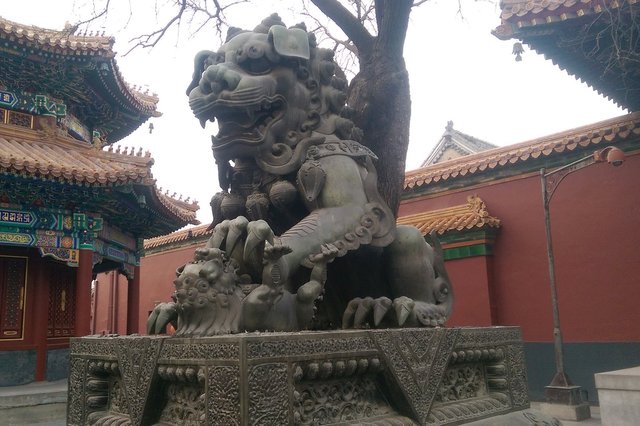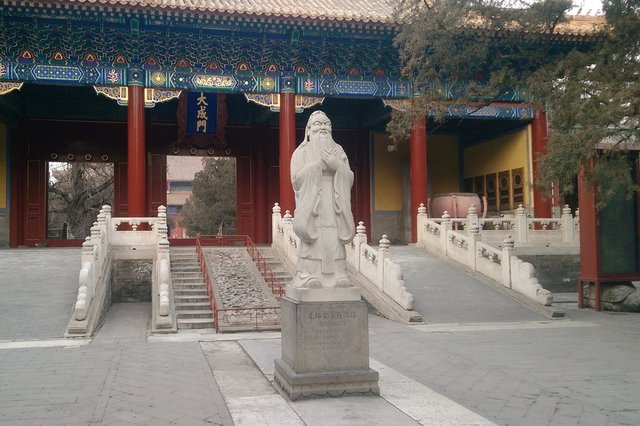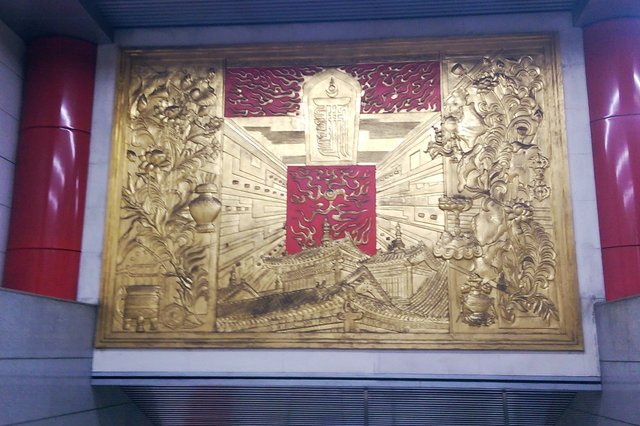Temple of Heaven
Started: 2016-03-06 19:26:06
Submitted: 2016-03-06 22:37:06
Visibility: World-readable
20 January 2016: In which the intrepid narrator sees another UNESCO World Heritage Site in Beijing
The day after seeing the Forbidden City, I headed to visit another UNESCO World Heritage Site from Imperial China: the park surrounding the Temple of Heaven, where Ming and Qing dynasty emperors would visit to ask for divine intervention for the next year's crops.
I took the metro to the Temple of Heaven and paid for admission to the park. The park was laid out on a north-south axis with the Circle Mound Altar in the south, the Hall of Prayer for Good Harvests in the north, and an elevated walkway linking the two sites.
I found that I liked the Temple of Heaven more than the Forbidden City. It had the same sort of architecture and design, but there was much less of it. The pavilions and temples and gates were far enough apart that I could appreciate each one of them in isolation, and they were separated by large expanses of trees bisected by picturesque paths.
I recognized the Hall of Prayer for Good Harvests as the iconic temple building, used as an icon of Beijing on the cover of my guidebook, and in the logo of the Beijing restaurant I visited in Taipei.
As I was taking pictures of the Hall of Prayer for Good Harvests, the battery on my SLR camera died. I'd been using it consistently for a week, and hadn't charged it yet, and I figured it probably didn't like the cold in Beijing any more than I did. I reluctantly stowed my camera and switched to using the camera on my phone to take pictures -- which were somewhat lower quality but still better than nothing.
On my way out of the park I stopped by the souvenir shop and looked around the trinkets until I found a pair of Chinese lions, cast in bronze, that I wanted to buy. I bought a matched set: a lioness with a cub under her left paw, representing fertility; and a lion with a sphere under his right paw, representing power. They were the right size to put on my bookshelf, along with the other artifacts from other trips (mostly to various parts of Asia) on display there.
I exited the park and saw vendors selling an artifact I'd seen previously in Beijing, which I decided to get for Willy, at the right mixture of kitsch and culture. (I will keep the specific nature of this artifact secret until I've had a chance to actually deliver it to Willy, at which point I will try to remember to come back here and update the post.) The vendor noticed my interest and quoted me ¥30. I offered ¥20 and she agreed (which probably meant that I offered too much -- but it was only US$3 so I wasn't really getting a bad deal in any meaningful sense). I dug around in my wallet for the appropriate change, but I only found a ¥10 note, plus larger bills. Just as I was beginning to worry that I didn't have the right change, the vendor spotted a US$2 bill in my wallet*, remarked that it was an unusual denomination that she hadn't seen, and offered to take it in lieu of the remaining ¥10. At the current exchange rate US$2 was about ¥13, so the final price was above the negotiated value, but it was close enough I let her have it.
[* I received the US$2 bill as change while visiting Coit Tower in San Francisco in October. The tower charged US$8 for admission, and I assume someone had the bright idea to ask their bank for a bunch of US$2 bills to use as change. I had been carrying the bill around in my wallet since then, since I don't normally use cash.]
I headed back to the metro and rode to line 10, under the third ring road*, where I found the weird CCTV headquarters building towering above the expressway. As I was taking pictures of the building, a middle-aged Chinese man came by and said, referring to the building, "No good -- everybody says very bad." I agreed that the building was very weird, and that was the reason I was here gawking at it. "Dutch man!" he added, presumably referring to the Dutch architect Rem Koolhaas, who was responsible for this particular building.
I think this building is weirder than the Oriental Pearl TV Tower in Shanghai, but I have to confess that I'm not quite sure. This building at least has the benefit of being habitable and used as office space, but the Oriental Pearl TV Tower does acknowledge that it is nothing more than a kitschy tourist trap.
[* In Beijing, the "ring roads" are orbital expressways in concentric circles that form the main road transportation network of the city. The right-of-way under the second and third ring roads are used by two orbital metro lines.]
I took the metro two stops north and wandered around the alleyways until I found The Bookworm, an English-language bookstore and cafe. I ate lunch, then looked around the collection of books for sale, which was modest compared to the selection I'm used to back home, but it was the biggest English-language book collection I'd seen in China -- and it did tend to have a focus on China. I bought a book about buildings in Shanghai, and a Mandarin Chinese phrasebook -- which I'd been wanting to buy since landing in China and realizing that I really didn't know as much practical Mandarin as I thought.
I walked back to the metro stop, carrying a shopping bag from the bookstore, when an American women walking on the sidewalk towards me pointed at my shopping bag and exclaimed, "This! Where is this!" She and her companions had been walking around in circles trying to find the bookstore. I gave them the best directions I could -- we were still fairly close to the bookstore, but it was tucked away on an alleyway that was easy to miss -- and they went on their way towards the store.
I took the metro to the Yonghegong Lama Temple. While exiting the metro station I felt an icy wind, normal for Beijing, but imbued with the scent of incense from the temple. The street in front of the temple was lined with shops selling Tibetan artifacts, all of which seemed to be playing the chant "om mani padmi om".
I paid for admission to the Tibetan Buddhist temple, which came with a box of incense, which I placed in groups of three sticks each at the alters I encountered. The temple complex sprawled over a half-dozen individual temple buildings, each more impressive than the last, culminating in a giant idol several stories tall.
I was somewhat surprised to see a prominent Tibetan Buddhist temple in the middle of Beijing, given the antagonism the central government has shown to certain expressions of Tibetan religion, but I suspect they chose to support the temple to emphasize the historic role of Tibetan Buddhism in China (the temple was built by one of the Ming dynasty emperors, who was an adherent of the sect) to support the territorial claim on Tibet.
I headed across the street to the Confucius Temple, which looked broadly similar in terms of architecture, but the individual icons were different: the statues and idols depicted Confucian elders rather than Bodhisatvas. The temple also served as the central examination site for administering the Confucian examinations for civil service in imperial China, and large stone tablets in the outer courtyard bore the names of everyone who had ever completed the highest level of Confucian examination in Chinese history.
By the time I finished seeing the Confucius Temple, it was about 17:00. The tourist sites were closing for the day, the sun was setting, and it was beginning to get cold. I took the metro back to my hotel and ate supper at the noodle bar in the lobby, which was quite good, and also meant I didn't have to brave the cold to eat.
For more photos from my day in Beijing, see Photos on 2016-01-20.





